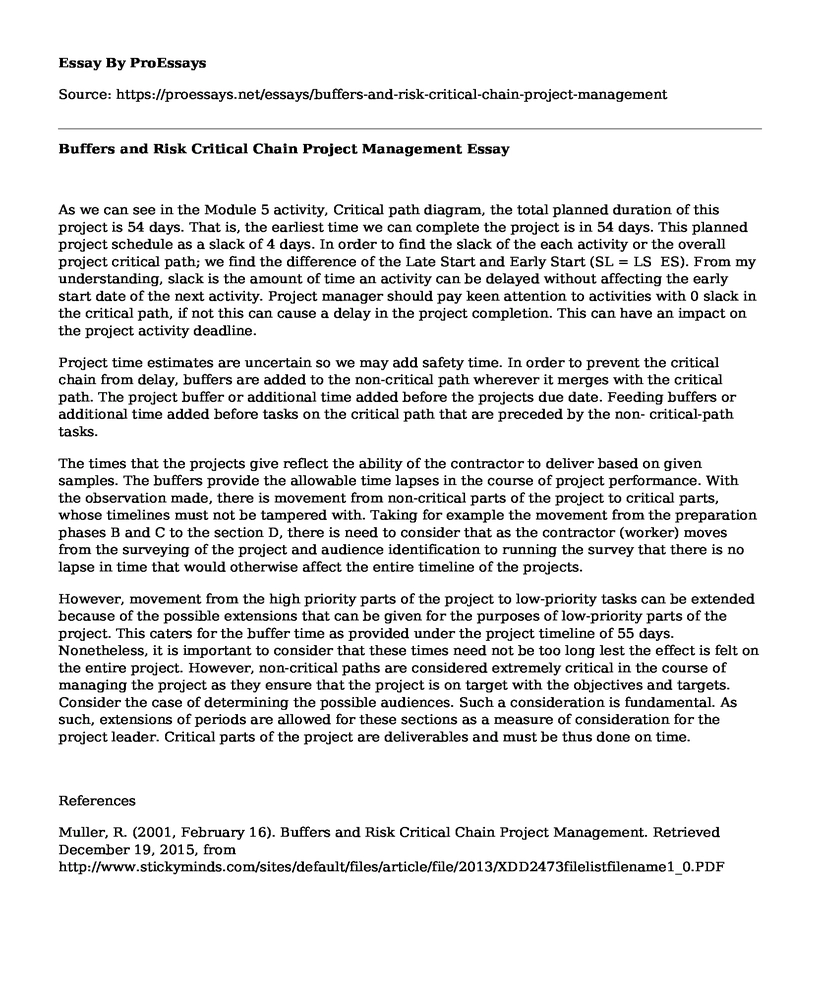As we can see in the Module 5 activity, Critical path diagram, the total planned duration of this project is 54 days. That is, the earliest time we can complete the project is in 54 days. This planned project schedule as a slack of 4 days. In order to find the slack of the each activity or the overall project critical path; we find the difference of the Late Start and Early Start (SL = LS ES). From my understanding, slack is the amount of time an activity can be delayed without affecting the early start date of the next activity. Project manager should pay keen attention to activities with 0 slack in the critical path, if not this can cause a delay in the project completion. This can have an impact on the project activity deadline.
Project time estimates are uncertain so we may add safety time. In order to prevent the critical chain from delay, buffers are added to the non-critical path wherever it merges with the critical path. The project buffer or additional time added before the projects due date. Feeding buffers or additional time added before tasks on the critical path that are preceded by the non- critical-path tasks.
The times that the projects give reflect the ability of the contractor to deliver based on given samples. The buffers provide the allowable time lapses in the course of project performance. With the observation made, there is movement from non-critical parts of the project to critical parts, whose timelines must not be tampered with. Taking for example the movement from the preparation phases B and C to the section D, there is need to consider that as the contractor (worker) moves from the surveying of the project and audience identification to running the survey that there is no lapse in time that would otherwise affect the entire timeline of the projects.
However, movement from the high priority parts of the project to low-priority tasks can be extended because of the possible extensions that can be given for the purposes of low-priority parts of the project. This caters for the buffer time as provided under the project timeline of 55 days. Nonetheless, it is important to consider that these times need not be too long lest the effect is felt on the entire project. However, non-critical paths are considered extremely critical in the course of managing the project as they ensure that the project is on target with the objectives and targets. Consider the case of determining the possible audiences. Such a consideration is fundamental. As such, extensions of periods are allowed for these sections as a measure of consideration for the project leader. Critical parts of the project are deliverables and must be thus done on time.
References
Muller, R. (2001, February 16). Buffers and Risk Critical Chain Project Management. Retrieved December 19, 2015, from http://www.stickyminds.com/sites/default/files/article/file/2013/XDD2473filelistfilename1_0.PDF
Cite this page
Buffers and Risk Critical Chain Project Management. (2021, Mar 02). Retrieved from https://proessays.net/essays/buffers-and-risk-critical-chain-project-management
If you are the original author of this essay and no longer wish to have it published on the ProEssays website, please click below to request its removal:
- Industrial Psychology Essay
- Corporate Power and Politics Essay
- One Card Solution: Economic Analysis of a New Product
- Risk Management and Insurance Essay Example
- Essay Example on Safety First: Improving Transportation Security Together
- Paper Example on Gig Economy: Impact of Short-Term Contracts on Organizational Culture
- Paper Sample on Stakeholders: Key to Change Project Success or Failure







